Skillshare vs. Udemy: Which One Is Best For Your Course?
Matthew Turner
Updated by Tara Malone
One of the biggest decisions an online course creator has to make is which platform to choose for their online course.
There are tons of course platforms out there, which can make choosing one seem like a daunting task. To make this process a little simpler, we decided to create an article where we compare two of the largest online course platforms around: Skillshare and Udemy.
In this Skillshare vs. Udemy comparison, we’ll look at pricing, core features, the course setup process, and more for each of these platforms.
By the end of the article, you should have an in-depth understanding of each platform and a clear sense of whether one of them is right for your online course.
Now let’s dive into this Skillshare vs. Udemy comparison!
What is Skillshare?
Skillshare is an online learning community for creators, freelancers, and lifelong learners.
With dozens of categories covering the Creative, Business, Technology, and Lifestyle industries, there are thousands of classes to choose from.
What makes Skillshare different from a lot of other platforms is that a student purchases a subscription and then has access to any course they like. In this way, it’s like the Netflix of the online course world.
What is Udemy?
Udemy offers the largest collection of online courses, with 100,000+ available across dozens of categories, ranging from Design and Marketing to Personal Development and Health & Fitness.

Unlike Skillshare, students purchase a course on an individual basis.
The price of courses varies, but most are available for under $100.
And speaking of price…what does it cost you, the course creator, to join each platform?
The answer is nothing!
As a course creator, it costs you nothing to set up an account and create a course.
You can create one course or ten, and the cost to you remains zero.
The way you earn money does differ, though, and depending on how popular your course becomes, it could have a major impact on the income you generate.
Skillshare: What You Can Earn Each Month
As a Teacher on Skillshare, you earn money based on a royalty system.
Each month, between 30% and 50% of Skillshare’s total Premium Membership revenue goes to a royalty pool for teachers. The rest of the money goes toward marketing, website improvements, and keeping the Skillshare platform afloat.
And because Skillshare is a subscription-based service, the total pool does vary each month.
The more members Skillshare has, the bigger the pool for teachers.
The fewer members Skillshare has, the smaller the pool is.
However, the actual revenue you earn depends on the number of minutes your videos get watched.
This means that the more students you have watching your videos, the more money you earn.
So let’s say your courses account for 10% of ALL minutes watched by Premium students across the platform each month. The pool for the month is $150,000, meaning you earn $15,000.
It’s a simple and transparent process that Skillshare says earns its top teachers $3,000+ per month and those just starting out $200 (in their first month).
Udemy: What You Can Each Month
On Udemy, you can publish as many paid and free courses as you like. The money you earn depends on the actual number of courses you sell. The breakdown is:
- Instructor Promotion: 97% revenue share on sales made by instructors where the student purchases their course using an Instructor’s coupon or course referral link.
- Udemy Organic: 50% revenue share on organic Udemy sales where no Instructor Coupon is used.
- Paid User Acquisition Channel Sales: 25% instructor revenue share in most cases. In order to optimize sales, Udemy partners with affiliates or pays to advertise for courses.
NOTE: if you publish a Free Course, you get no commission from that.
Technically, you can price your course for as much as $199 (based on Udemy’s Price Matrix and Price standards). But the reality is that most courses are under $100 (with many sold at under $50).
So although you can potentially earn more income on Udemy, you face greater competition.
As you can see from this Skillshare vs. Udemy comparison, there’s potential to earn thousands of dollars of passive income each month through your Online Course(s). Udemy certainly offers a greater chance to earn more, but it does come at a price (more competition).
Skillshare vs. Udemy: Features and Benefits
Although Skillshare and Udemy share many of the same features and benefits, there are a few differences. Here are some of the main features and benefits of each platform:
Skillshare: The Main Features and Benefits
- Low-cost monthly subscription for students (with the first 2 months free).
- A smaller platform, meaning your online course gets greater visibility.
- For each student you refer to Skillshare, you get a $10 referral fee.
- Skillshare’s renowned for having great customer service (for both students and teachers).
- A smaller, tight-knit community of students who are loyal to the platform.
- Skillshare provides its students with offline access to courses.
- A great resources section to help you build and promote your online courses.
- Skillshare classes and courses are shorter and digestible by design.
- There’s a strong focus on Project-Based learning, which enhances engagement.
Udemy: The Main Features and Benefits
- Greater control over the pricing of your online course.
- Udemy heavily promotes, advertises, and markets your courses.
- A large community of 30+ million students.
- The ability to create both free and paid courses (and link them to one another).
- The chance to create Online Quizzes to create greater engagement with students.
- Coupons and discounts available on courses, driving new traffic to you.
- Udemy creates external partnerships with companies, helping to reach new audiences.
- Action-based email campaigns help create greater engagement with students.
- A wider selection of categories catering to almost any course creator.
Although both platforms offer a lot of important features and benefits, both fall short in a few areas.
Skillshare Cons:
- The platform is aimed at creatives, which makes it less relevant for business, marketing, and personal development.
- No certificates or accreditation for students who complete your course.
- The inability to upload additional class resources or materials, such as workbooks or quizzes.
Udemy Cons:
- Although Udemy does provide certificates to students, they’re not accredited.
- There are A LOT of poor quality courses on Udemy, which can negatively affect perception.
- As with larger platforms, customer service and communication isn’t great.
Many of the features in this Skillshare vs. Udemy comparison are similar to one another. They largely provide the same core benefits, mainly differing in how students access these courses.
- Udemy = pay as you go
- Skillshare = subscription-based
As such, the deciding factor for many course creators is the time it takes to set up, publish, and promote their course. Time dictates all, so just how easy is to create a course on Skillshare and Udemy?
Skillshare vs. Udemy: How To Create Your Course
Creating your online course on both Skillshare and Udemy is simple, yet each process differs. We’ll walk you through the general account set up for each now, as well as the steps you need to take to create your first course.
How To Create Your Course on Skillshare:
To begin with, you will need to create a new Skillshare account.
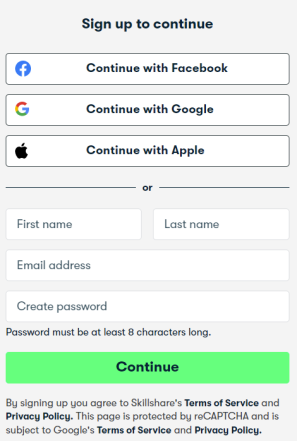
Once you’re signed in, the process can begin.
Step 1:
On the Home screen, click on Teach at the upper right and select Create a Class from the drop-down menu.
Step 2:
On the next screen, click the Start a Class button at the top right.
Step 3:
Next, click on Class Details and enter your class information: your Class Language, Class Title, Class Description, and Project Description.

Step 4:
Use the drop-down menus to enter your Class Category, Level and Class Skills tags. When all the fields are filled, save your class information.
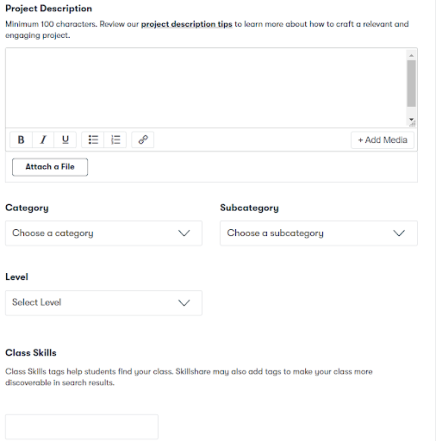
Step 5:
Next, click on Video Lessons on the left and start the process of adding your videos.

On average, Skillshare Classes last between 20 and 60 minutes. Yet it’s advised that you split this into smaller 2 to 3 minute videos (your class must be at least 10 minutes in length).
Unlike other course platforms, you cannot upload additional class resources, run quizzes, or publish audio descriptions/interviews. The focus is solely on video, which is a benefit for many course creators.
Step 6:
Once you’ve created and built your first Class, click Submit and make sure everything looks and works as it should do. Once complete, your Class layout will look something like this:
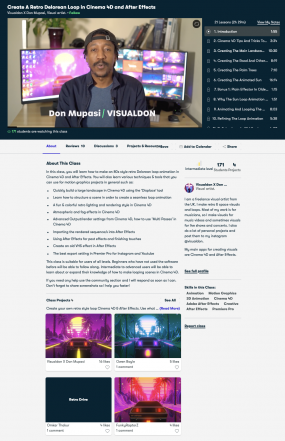
In terms of speed and ease, Skillshare certainly makes your life easy. Without the worry of additional resources and creating materials for each video, you can quickly create and upload your Classes.
So, how does this compare to Udemy?
How To Create Your Course on Udemy
Like before, you will first need to create a new Udemy account.
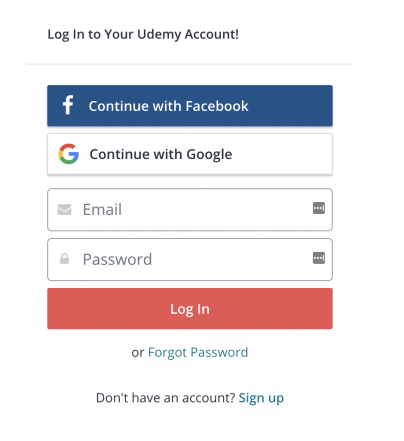
Step 1:
Once signed in, create either a new course or a practice test.
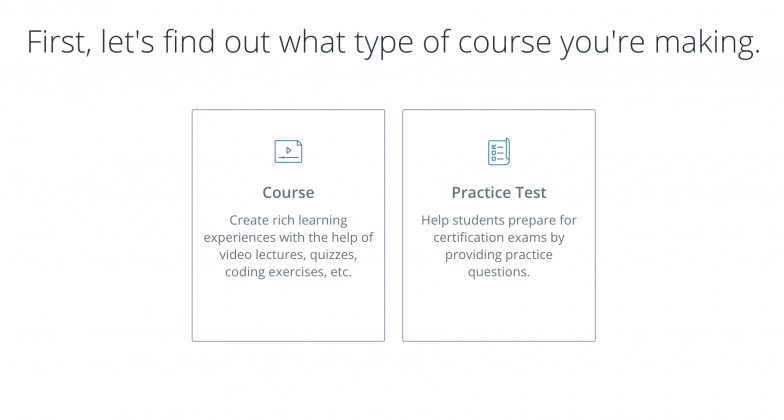
Step 2:
Create a Title for your new Online Course.
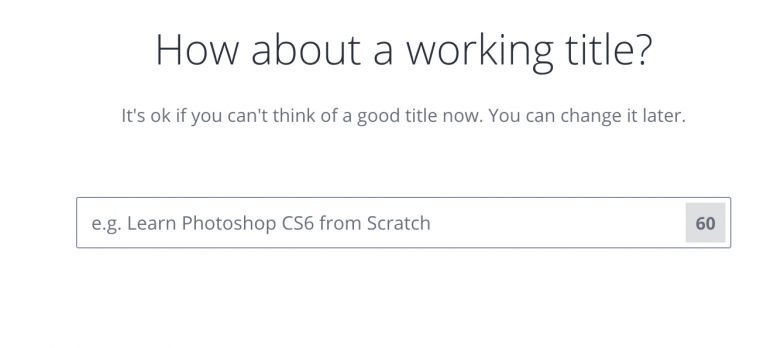
Step 3:
Choose a category for your new online course.

Step 4:
State how much time you can spend creating your course each week.
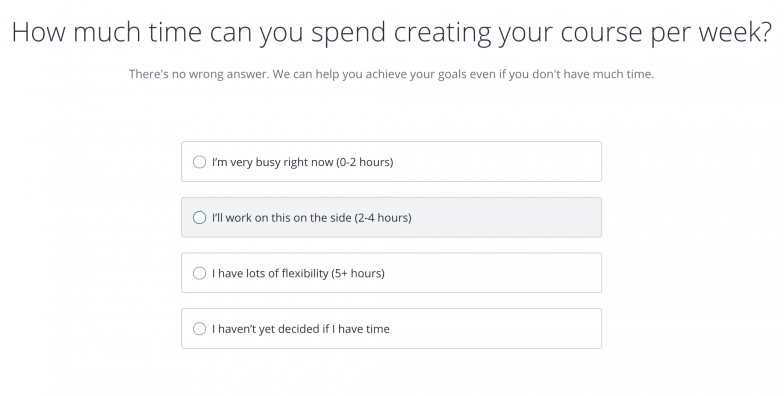
Step 5:
Fill in details about who your target student is, and any requirements you have of them.
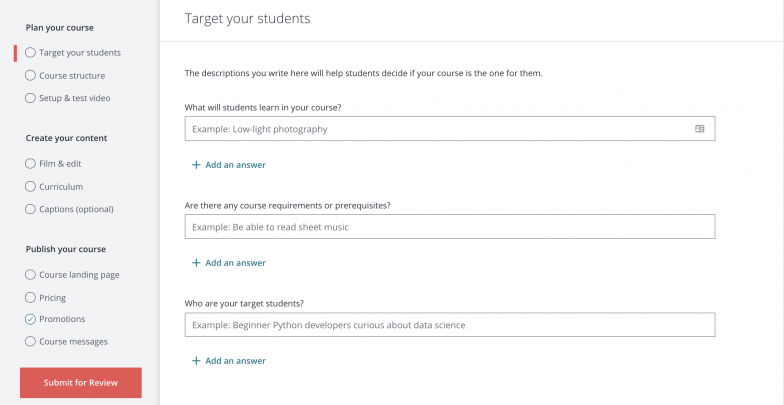
In addition to this, Udemy shares several resources on how to plan and structure your course. Some of these core resources include:
- How To Outline Your Course
- How To Plan your Practice Activities
- Setting Up Your Filming Studio
- Checking Your Video and Audio Quality
Step 6:
Once you’ve planned your course, it’s time to upload each individual lesson and its accompanying videos and resources.
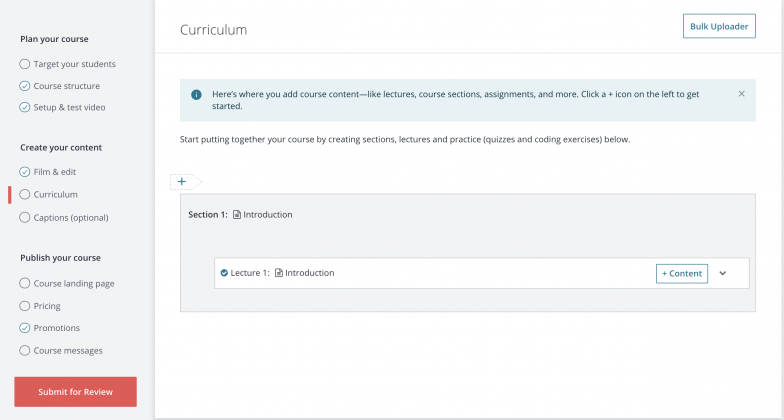
You can choose different content types for each lecture: video, video and slide mashup, and article.

In addition, you can enter a description to each lecture, and upload additional resources like PDFs, graphics, and external links.
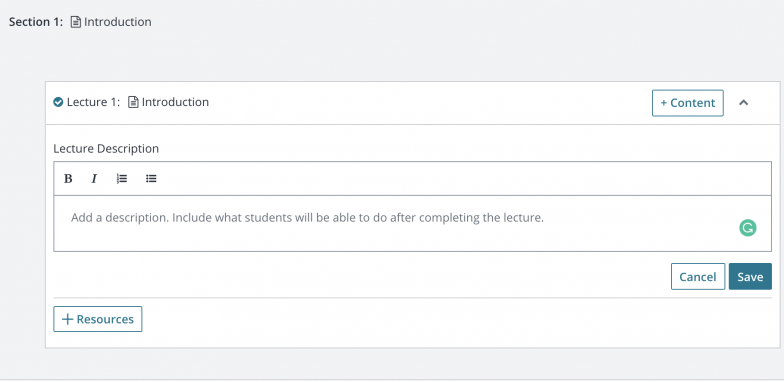
Here, you can add as many lectures per section as you like, and create different sections within your course to split up your content. Once you’ve uploaded your content, you can preview what your course looks like both from an instructor’s point of view and your students’.
Step 7:
Once complete, it’s time to publish your new online course, starting with your Landing Page.
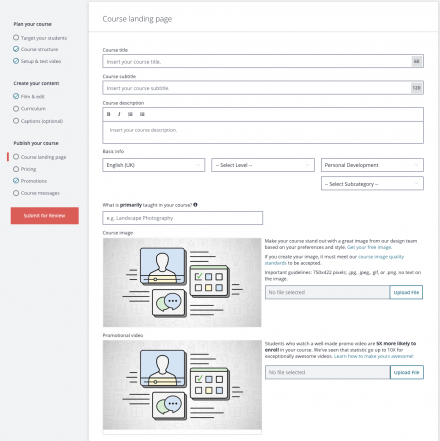
Step 8:
Next, it’s time to price your online course, choosing from several different currencies and various pricing options (starting at Free and going as high as $199.99).
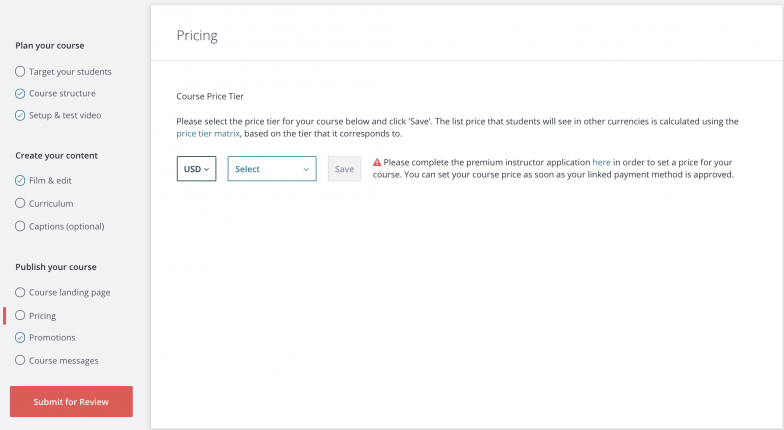
Step 9:
Finally, you can create a Welcome and Congratulations Message for your students, before submitting your course for review.
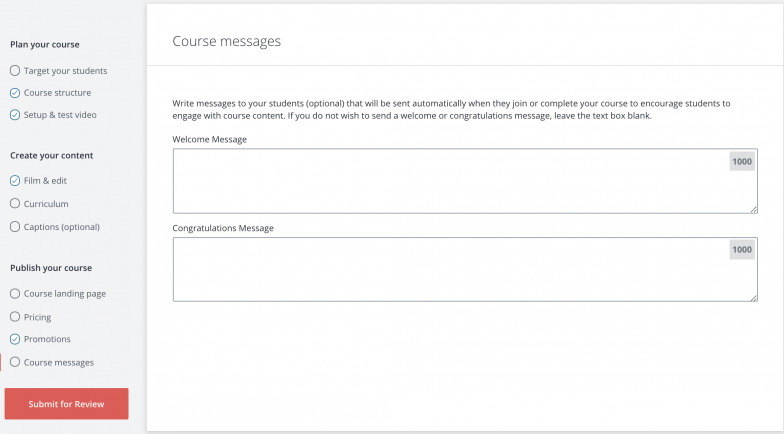
Compared to Skillshare, Udemy offers a lot more in terms of options and flexibility. But this does come at the expense of time. Even with a short, free course, you’ll likely need to reserve at least 2 to 3 hours to get your first course up and running.
Skillshare vs. Udemy: The Student Experience
No matter what online course you create, the most important people are those you create it for.
As such, no Udemy vs. Skillshare Comparison could be complete without taking into account the Skillshare vs. Udemy student experience (and which platform aligns best with different personality types).
Let’s begin with what’s often the most important factor…price!
Pricing
Skillshare’s subscription model is a popular one among today’s younger generations. Used to the likes of Netflix, the option to pay $15 per month for an unlimited number of courses and classes appeals to many.
And with a free two-month trial available, it gives students a chance to test 2 to 3 courses with no risk.
However, unless you wish to constantly take new classes and learn each week, Udemy’s one-time payments could be more appealing. You also get lifetime access when purchasing a course on Udemy.
So although a subscription model does work for many, if your students are busy business owners with little time to spare, Udemy may make more sense.
Categories
Skillshare targets creative people and craft-makers. Although they have some “lifestyle” classes, the majority of their teachers focus on the arts. If your students fall under this description, Skillshare could be ideal for you.
Whereas Udemy appeals to the masses, providing courses in dozens of categories across dozens of industries (including business, sales, marketing, design, personal development, and many more).
Content Type
Skillshare appeals to students that prefer bite-sized content that requires little time to consume. Most classes last around 60 minutes, with most videos split into 2 to 5 minute segments. It’s fast and digestible, and aligns with its subscription model.
Udemy, on the other hand, offers more in-depth courses that expand beyond video.
It allows instructors to delve deeper into a subject and give their students what they need.
Whereas with Skillshare, most classes focus on the basics without going too deep.
Community
One of the standout features for Skillshare is that many of their classes are community-based, which means you don’t learn on your own. Instead, you’re part of a small, tight-knit community that drives one another to complete each class.
Whereas courses on Udemy cater to those who like to work on their own. There are still community features, but these are less relevant (especially with the size of the Udemy universe).
If community is important to your students and you, Skillshare has the upper hand.
Customer Service
With a smaller community, Skillshare is able to offer its students (and teachers) more help, guidance, and support. It’s renowned for its customer service and personal touch.
Whereas with Udemy, as often is the case with larger products, you may have to wait for help.
Overall, your students get a great experience on both platforms. That said, each one caters to different learning styles, situations, and industries. It’s important to take into account the Skillshare vs. Udemy student experience when choosing the platform for your own course.
Udemy vs. Skillshare Comparison: 5 Key Points to Consider
To complete this Udemy vs. Skillshare comparison, let’s overview the key points to consider as you decide which platform is right for you and your students.
1: Time Commitment
You need to consider how much time you can commit to your online course and how quickly you wish to publish it. It’s also important to take into account how many courses you wish to create in the future.
If your time’s limited, Skillshare may appeal to you. Within a few hours, you could record, edit, and upload your entire course. It’s also easier to create new courses on Skillshare, without it taking up much of your time each week.
Whereas the entire process takes much longer on Udemy. If you wish to create a GREAT course with additional resources that utilize features like Quizzes, you’ll likely need to set aside 3 to 5 hours per week over a couple of months.
2: Income Potential
One of the main reasons entrepreneurs and business owners create an online course is to generate extra income. Both Skillshare and Udemy provide this, yet the ceiling is set much lower on Skillshare.
They state that their best-performing teachers earn upwards of $100,000 per year. This is substantial, yet it likely takes a lot of classes and a lot of ongoing community engagement.
Plus, your income is directly linked to Skillshare’s growth. If they lose subscribers, your ability to earn on the platform goes down with it.
With Udemy you not only have access to more people but have greater freedom over how you price your courses. Udemy’s size comes with its negatives, but the potential to earn more passive income is greater compared to Skillshare.
3: Promotion and Reach
One of Udemy’s core benefits is both the size of its platform and how it actively promotes, advertises, and creates partnerships with other online influencers. This results in greater reach for you as a content creator, and therefore the potential to earn more income.
Skillshare, on the other hand, caters to a smaller audience. This does create loyalty and more of a community feel. But it comes at the expense of promotion and reach.
4: Content Creation and Features
How do you envision your online course?
If it’s solely video-based with few other resources — and you like the idea of creating bite-sized content that’s easy to digest — Skillshare is the platform for you.
Whereas if you want to create a more comprehensive course that dives deeper into your subject (with workbooks, interviews, slide shows, quizzes and more), Udemy offers you greater freedom.
5: Student Experience
Once again, the most important person in this whole process is your student.
- What do they want?
- How do they learn?
- How much time do they have?
Skillshare offers the perfect solution and experience for some students.
Udemy offers it to others. What matters is that you take into account who YOU serve.
By providing your students with what they need, you greatly increase your chances of success.
Skillshare vs. Udemy: Is One of Them Right For You?
Having read this Udemy vs. Skillshare comparison, you should have a clearer sense of what each platform is all about and whether one of them might be right for your online course.
You might decide that neither of them will work for your course, and that’s okay. There are plenty of other platforms out there you can consider.
But if you decide that one of these platforms is right for your course, then set up your Skillshare or Udemy account and start building your course today!
To learn more about the process of creating online courses, you may want to join us in our Hybrid Courses Bootcamp. It’s completely free to join and teaches you how to create a successful and profitable online course.
Let’s Start Building Your Online Course!
In our FREE Hybrid Courses Bootcamp, we’ll walk you through how to transform your knowledge and expertise into a profitable online course… one your students will love.